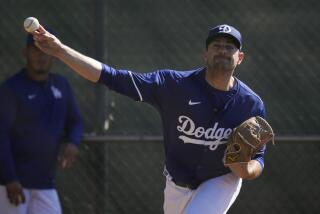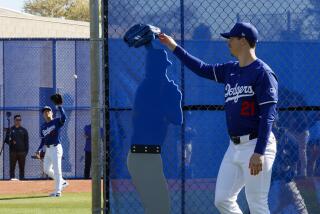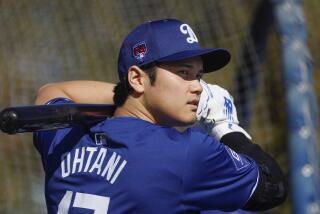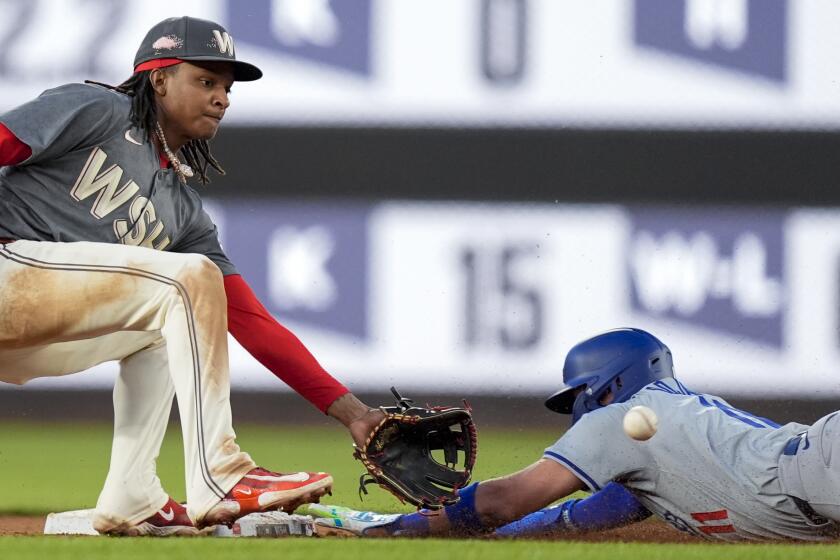Injury-prone Dodgers pitcher Brett Anderson hopes to be effective

Ask Dodgers pitcher Brett Anderson to recite a list of his injuries over the last four years and it sounds as if he’s reading from an anatomy textbook.
“Right foot, left finger,” he begins. “Back, elbow.”
There are few major body parts that have been spared.
“It’s like a stunt double,” he said. “For me, being fairly unathletic, to hurt so many parts of my body, that’s pretty remarkable.”
If that’s the case, then both the pitcher and the Dodgers are hoping this season is unremarkable. Because if anyone is overdue for some good luck it’s Anderson, who has spent more time on the disabled list than on the active roster since 2010.
He’s been sidelined three times because of left elbow issues that led to Tommy John surgery. He underwent another surgery for a herniated disk in his back, strained a muscle in his side, broke a bone in his pitching hand and another in his right foot, went on the DL because of a twisted ankle and came out of a game last summer with a blister.
But in between Anderson has shown flashes of brilliance, winning 11 games as a rookie with Oakland in 2009, and posting a 2.91 earned-run average — albeit in 43 innings — for the Colorado Rockies last season. The Dodgers are betting that if Anderson can stay healthy he can still produce like that, which is why they signed him to an incentive-laden contract worth at least $10 million to be their fifth starter.
In his first two spring starts Anderson threw five shutout innings. But Thursday, after his pregame warmup was interrupted because the Angels’ team bus was stuck in traffic, Anderson lasted only 1 1/3 innings, giving up three runs and seven hits. “It was terrible by all standards,” he said.
Rick Honeycutt, the Dodgers pitching coach, said of Anderson, “The ball’s coming out good. He’s bounced back every time. He’s done every program, every routine. Not many issues at all.”
There are questions, though, because Anderson has made just 19 starts since June 2011. And he hasn’t pitched more than 84 innings in a season since 2010.
Yet most of Anderson’s injuries have been freakish in nature. He broke the index finger on his left hand swinging a bat. He twisted his ankle throwing a pitch. And the strained oblique happened when he added a little extra torque on his delivery.
“Obviously it’s tremendously frustrating,” he said. “I think it would be more frustrating if it had been constantly my shoulder or constantly my elbow or something like that.
“The fact that it’s been all over and, for the most part, things I couldn’t have prevented, hopefully you can see light at the end of the tunnel.”
Too often that light has been the one on the end of an X-ray machine, which Anderson hopes to avoid this summer through hard work and perseverance. He spent much of the winter in Arizona working with physical therapist Brett Fischer, the man who helped Randy Johnson win four Cy Young Awards after undergoing back surgery similar to one Anderson had last August.
Anderson also showed up at the Dodgers’ spring-training complex and began throwing well ahead of the rest of the staff.
“That’s the beauty of our game. Every year’s a new year,” Honeycutt said. “Whatever’s happened in the past — good year, bad year — it’s like the previous game. You’ve just got to let it go.”
Anderson is doing more than that. Now he’s trying to put a positive spin on the list of injuries. Other pitchers selected with him in the 2006 draft — the Dodgers’ Clayton Kershaw, the Giants’ Tim Lincecum, the Nationals’ Max Scherzer and Doug Fister — have all thrown twice as many big league innings as Anderson. And that has the 27-year-old thinking he’ll be able to stick around a little longer than his contemporaries.
“I’ve been kind of able to conserve the bullets as far as the arm goes,” he said. “You see guys like Clayton, you see the guys that are my age or in my draft class, and you go ‘what if?’ It’s one of those things you can’t really dwell on too much. But hopefully going forward I can show myself — and everybody — what kind of pitcher I am.
“Hopefully it’s my year.”
Twitter: @kbaxter11
More to Read
Are you a true-blue fan?
Get our Dodgers Dugout newsletter for insights, news and much more.
You may occasionally receive promotional content from the Los Angeles Times.







